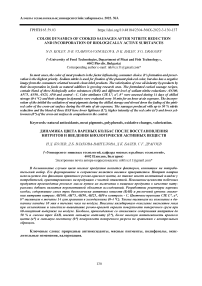Color dynamics of cooked sausages after nitrite reduction and incorporation of biologically active substances
Автор: Kolev N. D., Vlahova-vangelova D. B., Balev D. K., Dragoev S. G.
Журнал: Вестник Алматинского технологического университета @vestnik-atu
Рубрика: Технология пищевой и перерабатывающей промышленности
Статья в выпуске: 3 (137), 2022 года.
Бесплатный доступ
In most cases, the color of meat products is the factor influencing consumer choice. It’s formation and preservation is the highest priority. Sodium nitrite is used for fixation of the pleasant pink-red color, but also has a negative image from the consumers oriented towards clean label products. The valorization of rose oil-industry by-products by their incorporation in foods as natural additives is growing research area. The formulated cooked sausage recipes, contain blend of three biologically active substances (BAS) and different level of sodium nitrite reductions: AN100, AN75, AN50, AN25, AN0 and control - C. Color attributes CIE L*, a*, b* were assessed during 14 days of chilled storage (0-4 °C) and their changes in dynamics were evaluated every 10 min for an hour at air exposure. The incorporation of the inhibit the oxidation of meat pigments during the chilled storage and slowed down the fading of the pinkred color of the cross-cut surface during the 60 min of air exposure. The sausages produced with up to 50 % nitrite reduction and the blend of three BAS have lower lightness (L*), higher intensity of the red color (a*) and lower yellowness (b*) of the cross-cut surface in comparison to the control.
Natural antioxidants, meat pigments, polyphenols, oxidative changes, valorization
Короткий адрес: https://sciup.org/140295728
IDR: 140295728 | DOI: 10.48184/2304-568X-2022-3-130-137
Текст научной статьи Color dynamics of cooked sausages after nitrite reduction and incorporation of biologically active substances
ГРНТИ 65.59.03
The color of meat and meat products is the most important sensory characteristic that is crucial for consumer choice (Dragoev et al., 2014; Abdulhameed et al., 2016). The pink-red color of the meat products is due to presence of nitro-sylhemochrome, formed through series of reactions (Suman et al., 2016). Sodium nitrite (E 250) is the second most used additive in meat processing after the table salt (Vossen et al., 2012). Nitrites are classified as preservatives and used in three major aspects: color fixation, antimicrobial effect against pathogens and inhibition of oxidation (Serikkaisai et al., 2014; Grispoldi et al., 2022). When presented in meat matrix sodium nitrite dissociates rapidly, forming nitric oxide (NO). The meat pigment, myoglobin (Mb) binds the NO, forming nitrosylmyoglobin (NOMb), the second of which denature into nitrosylhemo-chrome upon cooking (AMSA, 2012). The growing consumers’ demand for clean label products led to a search for reduction or replacement of the synthetic additives with natural (Balev et al., 2014; Serikkaisai et al., 2014). But the color stability and intensity of meat products, decreases even after partial reduction of the nitrites (Bulambaeva et al., 2014; Grispoldi et al., 2022). It’s due to lower formation of NOMb and oxidation ofthe Fe2+(fer-rous) heme iron in native Mb to Fe3+ (ferric) in metmyoglobin (MetMb), having brown or tannish-gray color (Dragoev et al., 2014). In order to partially reduce nitrites, a way must be sought to stabilize the meat pigments via use of reducing agents or antioxidants (Sepe et al., 2005; Vlahova-Vangelova et al., 2014). With the development and growth of industrial food processing, the wastes are also increasing. Bulgaria and Turkey are globally known for the rose oil (Slavov et al., 2021). The tiny wield of the rose oil production lead to massive quantities of by-products (Gateva et al., 2022). Previous researches evaluated the composition of the ethanol extract dried rose (Rosa Damascena Mill.) petals, finding a rich spectrum of kaempferol and quercetin glycosides (Shikov et al., 2012; Dragoev et al., 2021). In our previous study we formulate blend of three biologically active substances (BAS) which showed great synergism and well-expressed stabilizing potential (Kolev et al., 2022). Therefore, the aim of this work is to assess the color kinetics of the cross-cut surface of cooked sausages, produced with blend of three biologically active substances and different levels of sodium nitrite reduction.
Materials and Research Methods
Main ingredients for the production of the cooked sausages were chilled beef shoulder and pork bacon (48 hpost mortem). The blend of BAS was formulated after mathematical optimization according four target functions and contain: 0.100 g/kg freeze-dried rose petals extract (FDRPE); 0.091 g/kg dihydroquercetin and 0.100 g/kg sodium L-ascorbate. All other ingredients were bought locally. The processing was done in the Department of Meat and Fish Technology at the University of Food Technology, Plovdiv, Bulgaria, following the recipes presented in Table 1.
Color measurements. At first the sausages were rested at room temperature for 30 min. The polyamide casing ofthe cooked sausages was pilled of and 3 cm thick slices were cut. Color attributes were assessed immediately after the cutting and every 10 minutes for an hour at air exposure. The color is presented by CIE L*, a*, b*, where: lightness’ values (L*) range from 0 to 100 or respectively from black to white; a* values represent the chromatic scale from green to red color (from -60 for green to +60 for red) and b* values correspond to the blue-yellow chromatic scale, respectively from -60 to +60 (Hunt et al., 2012). Measurements were done using a colorimeter Konica Minolta model CR-410 (Konica Minolta Holding, Inc., Ewing, New Jersey, USA) equipped with standard observer 2° and D65 illuminant. Calibration was done with white reference standard no.18833116 (Y = 94.3, x = 0.3134 and y = 0.3197).
Table 1. Formulation of the cooked sausages
|
C |
AN100 |
AN75 |
AN50 |
AN25 |
AN0 |
|
|
Beef shoulder, kg |
2.00 |
2.00 |
2.00 |
2.00 |
2.00 |
2.00 |
|
Pork bacon, kg |
2.00 |
2.00 |
2.00 |
2.00 |
2.00 |
2.00 |
|
Table salt, g |
88.00 |
88.00 |
88.00 |
88.00 |
88.00 |
88.00 |
|
Sugar, g |
4.00 |
4.00 |
4.00 |
4.00 |
4.00 |
4.00 |
|
Sodium tripolyphosphate, g |
8.00 |
8.00 |
8.00 |
8.00 |
8.00 |
8.00 |
|
Sodium nitrite, g |
0.40 |
0.40 |
0.30 |
0.20 |
0.10 |
- |
|
FDRPE, g |
- |
0.40 |
0.40 |
0.40 |
0.40 |
0.40 |
|
Dihydroquercetin, g |
- |
0.36 |
0.36 |
0.36 |
0.36 |
0.36 |
|
Sodium L-ascrobate, g |
- |
0.40 |
0.40 |
0.40 |
0.40 |
0.40 |
|
Flaky ice, kg |
0.60 |
0.60 |
0.60 |
0.60 |
0.60 |
0.60 |
Statistical analysis. Each presented result is Mean of five repetitions ± Standard error of means (SEM). To determine the significant differences (P<0.05) a Two-way ANOVA analyze was performed.
Results and their discussion
Color kinetics at 1-st d of chilled storage (0-4°C)
Taking in consideration that the higher the L* values are, the brighter the color of the cross-cut surface is. As for the cooked sausages higher lightness is preferred by the consumers (Abdulhameed et al., 2016). From Fig 1. a) it’s clear that the cooked sausages produced with absence of nitrites (AN0), have the highest L* values from 0 to 20 min, followed by AN75 and the control. The control is characterized by decreasing trend after the 20-th min, which can be due to the absence of the blend of three BAS and ongoing pigment oxidation. The L* values of AN100 (from 55.15 to 55.37), AN75 (from 55.70 to 55.92) and AN25 (from 54.91 to 55.08) were relatively stable trough all measurements with slight deviations. The blend of three BAS inhibits the pigment oxidation even after partial reduction of the sodium nitrite.
The L* values of AN0 are the highest at the 1-st d ofthe chilled storages but the a* values are the lowest (Fig 1. b)). That combination led to a bright gray color of the cross-cut surface, repelling the consumers. Those results are in agreement with the correlation between L* and a* values reported by Abdulhameed et al., (2016). In all of tested samples was evaluated a decrease in time (Bulambaeva et al., 2014). The higher redness of AN100 compared to the control, confirm the antioxidant effect of the three-component blend and inhibition of Fe2+oxida-tion to Fe3+(Suman et al., 2016). At the end of assessment (60 min) the highest a* values were in AN100 and AN75. The suggested in literature fading ofthe pink color due to exposure to light and air confirms our results (Hunt et al., 2012). At 0 min the control C a* values were comparable with AN75, 19.26 and 19.33, respectively. The oxidation of nitrosohemochrome in methemochrome led to browning ofthe cross-cut surface and the redness of the control C decreased.
At 0 min b* values of all samples were between 7.00 and 7.93. The control is characterized by fairly low yellowness (7.18±0.05) (Fig. 1 c)) but during the time of exposure and ongoing oxidative processes, color of the cross-cut surface turns from pink-red into brownish. Results show relationship between the decrease of a* values (from 19.26 to 15.07) and an increase in b* values (up to 8.92). The five experimental samples produced with blend of three BAS were characterized by relatively unchanging b* values from the start to the end of the exposure (Fig. 1 c)). The presented in the blend, dihydroquercetin is well studied bioflavonoid with high ferric reduction activity potential (FRAP) capable of inhibiting the oxidation of myoglobin forms (Dragoev et al., 2014). The stable b* values and slowly decreasing a* values of AN75 come as confirmation of the antioxidant potential of the blend against the pigment oxidation after 25% nitrite reduction.
From the observation on CIE L*, a*, b* at the 1-st d of the chilled storage of the cooked sausages we can conclude the following. The blend of three BAS stabilizes the color parameters after the reduction on added nitrites by 25%, making them comparable with AN100 and better that the control.
57.5

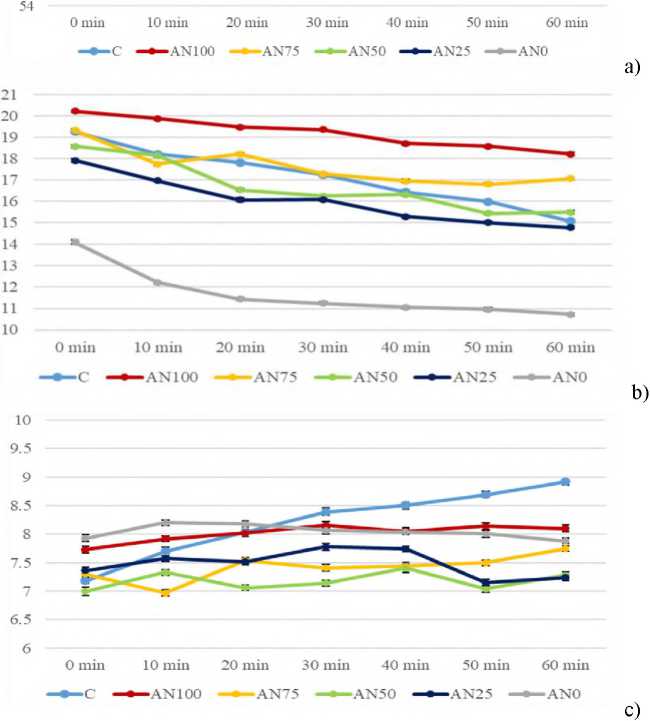
Figure. 1. Color kinetics at the 1-st d of chilled storage (0-4°C) during 60 min of air exposure of the cross-cut surface a) CIE L*; b) CIE a*; c) CIE b*
Color kinetics at 7-th d of chilled storage (0-4°C)
The brightest color was assessed in AN100, C and AN0 at the 0 min (Fig. 2 a)). The L* values of AN0 rapidly decreased during the exposure of air, but those of AN100 and C were stable. In the end (60 min) sausages produced with the blend of three BAS were significantly brighter (P<0.05) that the control ones. Similarly, to the evaluated at the first day (Fig. 1 a)) the lightness of AN75 undergo an increase (30 min) and decrease by the end of the measurement (Fig. 2 a)). Unlike all sausages tested, where a decrease in brightness was found during exposure to air, the values of AN75 at the beginning (0 min) and at the end (60 min) remained statistically indistinguishable.
The redness of the cross-cut surface of C, AN100, AN75 and AN75 at the seventh day of the chilled storage varies in tight range (Fig 2. b)). The observed at the first day oxidation of myoglobin form during the 60 min exposure to air and the associated decrease of a* values was observed again. The decreasing trend in AN100 and AN75 was to some extent slower and they were characterized by higher a* values compared to the control C at the end of the measurement. The presented in AN50 blend of three BAS was able to compensate the half nitrite reduction and at 60 min redness was same as of the control C, respectively 14.77 and 14.73. In samples AN25 and AN0 the fading of the pink-red color was greater and the blend was not able to preserve the color.
The highest values of b* at 0 min estimated in C (8.61) and AN0 (7.89) (Fig 2. c)), refer to the development of oxidative processes in the cooked sausages, either due to the absence of antioxidant mixture or the lack of nitrites. AN100 and AN75 b* values start to increase up to 30 min and stabilize until the end of the measurement (Fig 2. c)). Sausages produced with half reduced nitrite were characterized the lowest yellowness during the 60 min of air exposure (Fig 2. c)). Overall, the yellowness of the samples prepared with the blend of three BAS was similar with the assessed at the first day of the experiment (Fig 1 c)). The potential synergism between the rose extract, dihydroquercetin and sodium L-ascorbate extends the induction period by inhibition ofthe oxidative processes.
The results obtained at the seventh day of the chilled storage were not as linear as those at the first day. The blend of three BAS showed inhibition against the oxidation of meat pigments during the 60 min air exposure and probably during their chilled storage. Yet the samples with 25% reduced nitrite content or may those with 50% reduction had pleasant color characteristics.
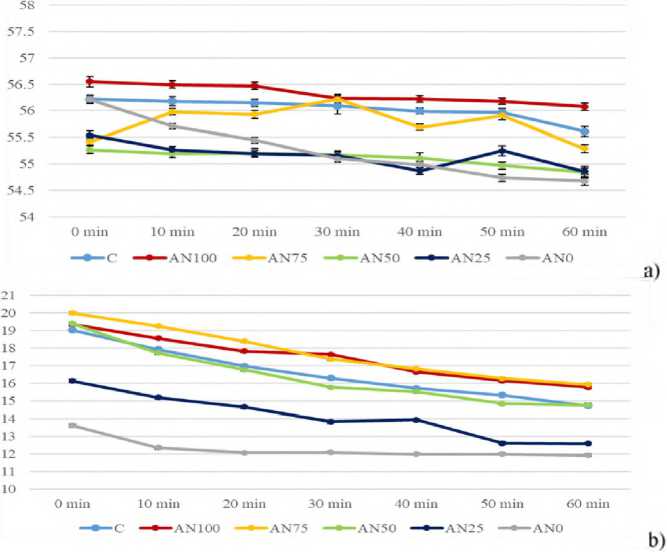
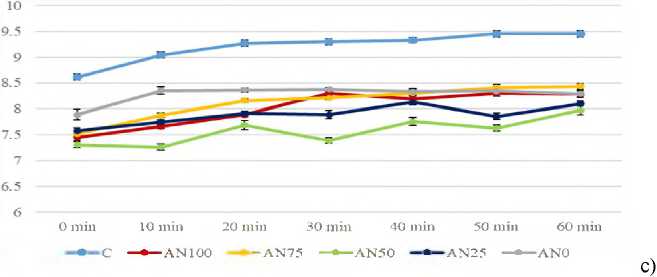
Figure 2. Color kinetics at the 7-th d of chilled storage (0-4°C) during 60 min of air exposure of the cross-cut surface a) CIE L*; b) CIE a*; c) CIE b*
Color kinetics at 14-th d of chilled storage (0-4°C)
Previous study reported correlation between the decrease of L* values and an increase of a* and b* values (Abdulhameed et al., 2016). The result at the end of the experiment (14 d) are to some extent in agreement with the previous statement (Fig 3 a)). The brightness of the control C increases (from 55.57 and 56.22 to 57.79) compared to the previous days in the same time redness decreases (from 19.26 and 19.03 to 18.87) but yellowness increases (from 7.18 and 8.16 to 8.53). All of those changes in the color characteristics of the control sausages led to brighter and grayish color of the cross-cut surface. The incorporation of the antioxidant blend decreased the L* values in AN100 and AN75 or increase their redness via inhibition of oxidative changes in the myoglobin forms.
The starting (0 min) a* values in AN100 and AN75 are indistinguishable (Р>0.05) and they are the highest trough all tested sausages (Fig 3 b)). For the time of the air exposure, they decrease in linear trend and at the end of the measurement are still the highest (Р<0.05). Through the whole evaluation the red color intensity in the control is significantly lower, which is confirmed by the highest evaluated L* values (Р<0.05) (Fig. 3 a)). Vossen et al. (2012)
report significantly higher redness and lower lightness of the color in porcine frankfurters with extract of Dog rose (Rosa canina L.). The polyphenol rich nature of all members of Rosaceae family makes their extracts potential functional ingredients capable of inhibiting the pigment oxidation. In the end of the chilled storage the blend of three BAS successfully inhibits fade of the cross-cut surface’s red color in the sausages with up to 25 % nitrite reduction, compared to the control - C.
The yellow color of the cross-cut surface in sausages AN50 and AN25 is less pronounced (Fig. 3 c)), as in the beginning of the air exposure (0 min), so as in the end (60 min). AN100 is characterized by the lowest increase of b* values around 3 % for the time of the exposure, while in the control - C the increase is 8.08 %. The results conclude that the blend of three BAS inhibits the oxidation of nitrosohemochrome in methemo-chrome and the respective change from pink-red to brown color of the cross-cut surface. Despite the ongoing oxidative processes during the 14-day chilled storage of sausages and probable consumption of substances with antioxidant properties, all samples with the incorporation of antioxidant blend are characterized by statistically lower b* values compared to the control - C.


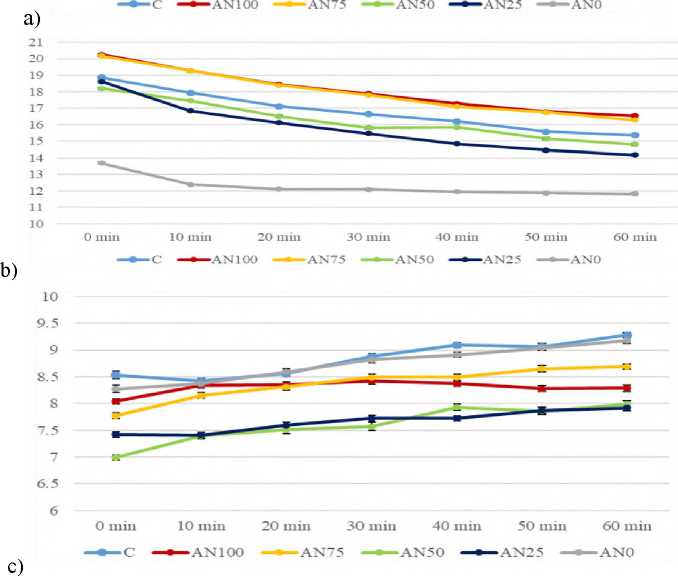
Figure. 3. Color kinetics at the 14-th d of chilled storage (0-4°C) during 60 min of air exposure of the cross-cut surface a) CIE L*; b) CIE a*; c) CIE b*
Conclussions
For the period of the experiment the sausages produced with the blend of three BAS are characterized by lower lightness (L*) compared to the control. Although the intensity of the red color in AN100, AN75 and in some sense AN50 was higher that the measured in the control. The oxidation of nitrosohemochrome in methemochrome and the increase in yellowness of the color was most pronounced in the control and AN0.
Based on the result we can conclude that the blend of three BAS containing 0.100 g/kg freeze-dried rose petals extract (FDRPE); 0.091 g/kg dihydroquercetin and 0.100 g/kg sodium L-ascorbate successfully works as replacement of the sodium nitrite up to 50 %.
ACKNOWLEDGEMENT
Список литературы Color dynamics of cooked sausages after nitrite reduction and incorporation of biologically active substances
- Abdulhameed, A. A., Yang, T. A., & Abdulkarim, A. A. (2016). Kinetics of texture and colour changes in chicken sausage during superheated steam cooking. Polish journal of food and nutrition sciences, 66 (3), 199-209. https://doi.org/10.1515/pjfns-2015-0044
- Balev, D., Vlahova-Vangelova, D., Dragoev, S., Mihalev, K., & Doncheva, T. (2014). Development of new functional cooked sausages by addition of rose petal extract. In II International Congress," Food Technology, Quality and Safety", 28-30 October 2014, Novi Sad, Serbia. Proceedings (pp. 111-116). University of Novi Sad, Institute of Food Technology. Available at: https://tinyurl.com/2p8fedmn
- Bulambaeva, A. A., Vlahova-Vangelova, D. B., Dragoev, S. G., Balev, D. K., & Uzakov, Y. M. (2014). Development of new functional cooked sausages by addition of goji berry and pumpkin powder. American Journal of Food Technology, 9 (4), 180-189. https://doi.org/10.3923/ajft.2014.180.189
- Dragoev, S. G., Staykov, A. S., Vassilev, K. P., Balev, D. K., & Vlahova-Vangelova, D. B. (2014). Improvement of the quality and the shelf life of the high oxygen modified atmosphere packaged veal by superficial spraying with dihydroquercetin solution. International Journal of Food Science, Volume 2014, Article ID 629062, 10 pages. https://doi.org/10.1155/2014/629062
- Gateva, S., Jovtchev, G., Angelova, T., Dobreva, A., & Mileva, M. (2022). The Anti-Genotoxic Activity of Wastewaters Produced after Water-Steam Distillation of Bulgarian Rosa damascena Mill. and Rosa alba L. Essential Oils. Life, 12 (3), 455. https://doi.org/10.3390/life12030455
- Grispoldi, L., Karama, M., El‐Ashram, S., Saraiva, C., García‐Díez, J., Chalias, A., ... & Cenci‐Goga, B. T. (2022). A study on the application of natural extracts as alternatives to sodium nitrite in processed meat. Journal of Food Processing and Preservation, 46 (3), e16351. https://doi.org/10.1111/jfpp.16351
- Hunt, M. C., King, A., Barbut, S., Clause, J., Cornforth, D., Hanson, D., ... & Weber, M. (2012). AMSA meat color measurement guidelines. American Meat Science Association, Champaign, Illinois USA, 61820, 1-135.
- Sepe, H., Faustman, C., Lee, S., Tang, J., Suman, S., & Venkitanarayanan, K. (2005). Effects of reducing agents on premature browning in ground beef. Food Chemistry, 93 (4), 571-576. https://doi.org/10.1016/j.foodchem.2004.04.045
- Serikkaisai, M. S., Vlahova-Vangelova, D. B., Dragoev, S. G., Uzakov, Y. M., & Balev, D. K. (2014). Effect of dry goji berry and pumpkin powder on quality of cooked and smoked beef with reduced nitrite content. Advance Journal of Food Science and Technology, 6 (7), 877-883.
- Slavov, A., Spasov, H., Dinkova, R., & Denev, P. (2021). MANAGING QUALITY OF AROMATIZED WINE PREPARED BY COFERMENTATION OF GRAPE MUST AND BY-PRODUCTS OF ESSENTIAL ROSE OIL INDUSTRY. Carpathian Journal of Food Science & Technology,13 (3). https://doi.org/10.34302/crpjfst/2021.13.3.4
- Suman, S. P., Nair, M. N., Joseph, P., & Hunt, M. C. (2016). Factors influencing internal color of cooked meats. Meat Science, 120, 133-144. https://doi.org/10.1016/j.meatsci.2016.04.006
- Vlahova-Vangelova, D., Balev, D., Dragoev, S., Kapitanski, B., Mihalev, K., Doncheva T. (2014). Influence of goji berry, pumpkin powder and rose petal extract on the quality of cooked sausages with reduced nitrite content. Proceedings of II International Congress, "Food Technology, Quality and Safety", October 28-30, Novi Sad, Serbia. Pp. 1-6. Available at: https://tinyurl.com/2p8fedmn
- Vossen, E., Utrera, M., De Smet, S., Morcuende, D., & Estévez, M. (2012). Dog rose (Rosa canina L.) as a functional ingredient in porcine frankfurters without added sodium ascorbate and sodium nitrite. Meat Science, 92 (4), 451-457. https://doi.org/10.1016/j.meatsci.2012.05.010

